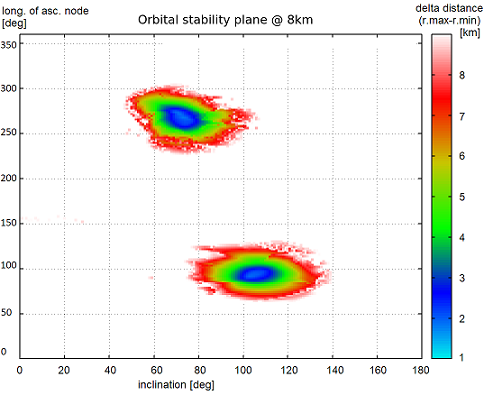Terminator Orbits around the Triple Asteroid 2001-SN263: A search for stable motion applicable to the mission ASTER
- 1German Aerospace Center (DLR), Berlin, Germany (kai.wickhusen@dlr.de)
- 2Technical University of Berlin, Germany
- 3Federal University of ABC, SBC, Sao Paulo, Brazil
Abstract
In this study we investigate the possibility of using terminator orbits that are stable over a period of three months to explore the triple near-earth asteroid (NEA) system 2001 SN263 with an orbiting spacecraft. We study in particular the case of the mission ASTER that is under study as the first Brazilian deep space mission [1].
Introduction
The interest in the first identified Near Earth Asteroid (NEA) triple system 2001 SN263 increased greatly when the Brazilian space agency announced ASTER, a rendezvous mission to explore this unique target [2].
The analysis of the observational data of 2001 SN263 [3] suggested that the primary is approximately a spheroid with an equivalent diameter of about 2.6 km (2.8×2.7×2.5 km) and smaller companions, about 700 m and 430 m in diameter orbiting at distances of 16.6 and 3.8 km, respectively.
For the spacecraft to move safely within the system, it is critical to identify and characterize regions of stability and instability (i.e., where collision or escape are imminent). Furthermore, observational and operational strategies to explore all three asteroids critically depend on availability of stable spacecraft orbits (i.e., orbits that do not requiring expensive correction maneuvers). In this study we search for stable orbits within the triple asteroid system. The orbits are considered stable when the spacecraft does not escape or collide with the system for 3 months.
Data and methods
We modelled the gravitational field of each body in two steps. First, we integrate the gravitational acceleration contributed by the mass of the object, represented by a polyhedron shape model (and assuming a homogeneous interior). In a second step, we replace this reference field with its spherical harmonics approximation.
The spacecraft trajectories around the triple asteroid are calculated with a numerical integrator which solves the equation of motion, taking into account all relevant forces:
with GM being the standard gravitational parameter of the primary body and being the spacecraft’s position and acceleration, respectively. The main acceleration acting on the spacecraft is caused by the system’s primary body, represented by a point mass, in the first term of the equation. Higher-order terms, which include the non-spherical gravity field of the main body, are included in the second term. The secondary and tertiary body are represented by the third term of the equation. Additionally, the large Solar System bodies, such as Sun and Jupiter are also included as perturbing forces in this third addend. The last term takes into account the solar radiation pressure acting on the spacecraft. The spacecraft is modelled based on the mass and dimensions as specified for ASTER mission [4].
Results and Conclusion
The results show that stable terminator orbits within the triple asteroid system can be found, for which the orbital plane is perpendicular to the incoming solar radiation.
These stable orbits are found between the semi-major axes of the secondary and tertiary body, i.e., at a distance between 4 km and 13 km from the primary’s centre.

Figure 1: Example of stability regions of the Aster S/C model in the triple asteroid system. The stability depends on initial orientation of the orbital plane which is represented by the longitude of ascending node and the inclination. Initial elements: semi-major axis=8km, eccentricity=0, remaining elements=0°. The colour coding shows the difference between largest and shortest distance to the primary body over 3 months.
The most stable region is located at semi-major axes between 7 and 12 km. In the best cases, the distance variation of the S/C absolute distance from primary’s centre (r.max-r.min) varies less than 1 km over a time frame of 3 months.
Figure 1 shows these stability regions at an exemplary initial distance of 8 km.
References
[1] Macau, E. E. N., Winter, O. C., Velho, H. F. C., Sukhanov, A. A., Brum, A. G. V., Ferreira, J. L., Hetem, A., & Sandonato, G. M. (2011). The ASTER mission: exploring for the first time a triple system asteroid. InProceedings of the 62nd International Astronautical Congress. Cape Town, SA.
[2] Sukhanov, A. A., Velho, H. F. C., Macau, E. E. N., & Winter, O. C. (2010). The Aster project: Flight to a near-Earth asteroid. Cosmic Research,48, 443–450. doi:10.1134/S0010952510050114.
[3] Becker, T. M., Howell, E. S., Nolan, M. C., et al. (2015). Physical modeling of triple near-Earth Asteroid (153591) 2001 SN263 from radar and optical light curve observations. Icarus, 248, 499, doi: 10.1016/j.icarus.2014.10.048
[4] Goretov, V., Lipatov, A., Linkin V. (2018) Description of the spacecraft on the EJP for near-earth and planetary research.
Acknowledgements
F.D. and J.O have been supported by a grant from the German Science Foundation (DFG-OB 124/19-1)
A.G.V. de Brum was supported by the São Paulo Research Foundation – FAPESP
(grant#2018/22672-4).
How to cite: Wickhusen, K., Damme, F., de Brum, A. G. V., Stark, A., Vincent, J.-B., Hussmann, H., and Oberst, J.: Terminator Orbits around the Triple Asteroid 2001-SN263: A search for stable motion applicable to the mission ASTER, Europlanet Science Congress 2020, online, 21 Sep–9 Oct 2020, EPSC2020-835, https://doi.org/10.5194/epsc2020-835, 2020.

